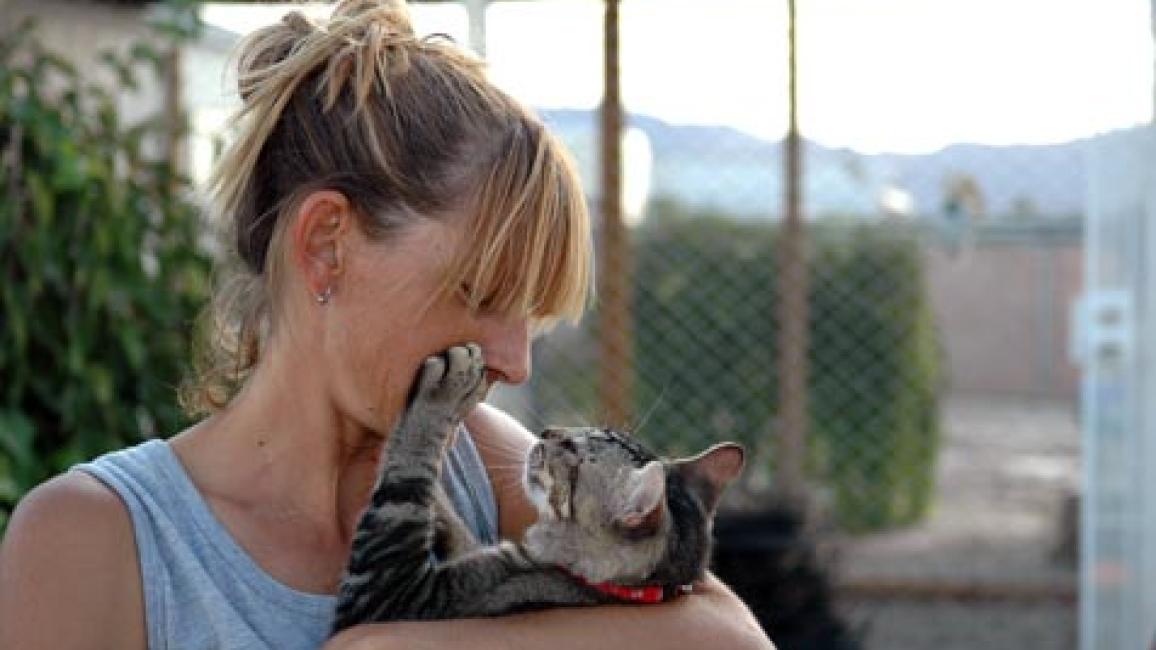Reconditioning frightened and skittish cats from large cat rescue

Every day in shelters across the country cats who are hissy, snarly or frightened are wrongly labeled feral and killed, but Best Friends’ experience in The Great Kitty Rescue has confirmed on a large scale that such cats can be saved with gentle persuasion.
Cat rescue in Pahrump, Nevada
Since local authorities asked us to intervene in mid-July, the massive rescue in Pahrump – at more than 700 cats, it’s likely the single largest cat rescue in history – has turned into an informal learning laboratory in cat behavior.
"When we first got into this rescue, I had a lot of people who wanted me to say how many were feral and how many were homeless pets," said team leader Sherry Woodard. "I told them, ‘I’m not going there. We won’t know until we start working with them. These cats have been abused and neglected; they are terrified, so how can we know which ones are housecats and how many are true ferals?’"
The first wave of cats was quickly adopted – they were obviously recent pets, although the Pahrump sanctuary was supposedly a feral cat facility.
But then an interesting phenomenon began taking shape.
Skittish and frightened cats and kittens get calmer
The Best Friends team would net the more frightened cats so they could be examined, vaccinated, microchipped and entered into the database. After the exams, they would leave the cats inside the building a day or so for observation. Repeatedly, those kitties who came in skittish would be calm and either actively solicit attention or least allow touch by the next morning.
In August, team members rounded up the cats, slowly and gently moving them from the trees and bushes, and cajoling them into the secured courtyard between the huts where they couldn’t hide as well. That helped, but there were still cats who refused to go into the buildings and ran in a frightened herd every time people approached.
The team realized that as long as the cats could run, they could not make progress. Since the number of cats at the compound was diminishing, they decided it was time to put all of them inside the buildings, including the supposed ferals. So in October, the Shy Cat Social Club was formed. Each of the buildings had a secure gate put in front of the building to prevent escapes.
"They are animals, they will do what works. So if they are afraid and you go away when they hide, or hiss, spit or strike out, then they will continue to do that," Sherry said. "What we are trying to do is break that cycle and use gentle persuasion to teach them they can’t scare us off.
Successes are common now; but she cautions that just because these kitties are getting more comfortable at the rescue, adopters and rescue groups should remember these are cats, and cats often don’t react well to change, even when it’s for the best.
Reconditioning the cats
"Over time the goal is for them to trust being touched. It takes persistence. We hear frequently now when these cats go home – they go into hiding. A couple of days or a couple of weeks, and then one day a cat will suddenly allow touch or even march into the living room and jump into someone’s lap."
About 70 of these "project cats" have gone to rescue groups all over the country who are willing to take them into their feline finishing schools.
The team is sharing the techniques that have helped the Pahrump cats, hoping they will work with others elsewhere.
The key is having patience and keeping in mind that some cats are true ferals and no matter how much gentle persuasion you use, they are the ones who should be admired from a distance.
"I think one of the big lessons is for us to get off of our human pedestal. Slow down and listen to the cats. People are animals too," Sherry said.
"But for everyone who has gotten involved in The Great Kitty Rescue, this is a work for the heart. It makes us all feel like we are doing something worthwhile. And thank you to everyone who has helped."
Photos by Molly Wald
Read more about the Great Kitty Rescue in Pahrump, Nevada.